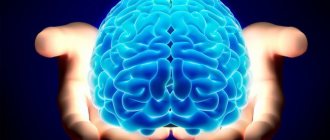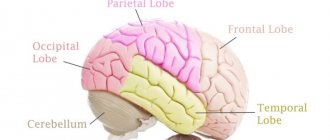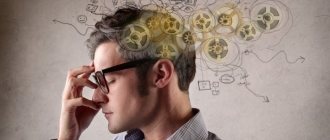We receive all the necessary information about the world around us through perception, or perception, as psychologists call this process. There is also a more primitive, elementary cognitive process - sensation, but it does not give a holistic idea of reality, and in itself we are not always even aware of it. We are not aware of how irritation occurs in the sensitive cells of the sensory organs (receptors), how a nerve impulse rushes at a speed of more than 100 m/s along neural circuits to a strictly defined area of the brain. The sensation that arises there is instantly processed, comprehended, associated with information stored in memory, and an image appears.
It is the product of perception - reflection of objects of the world in direct contact with them. The diversity of the surrounding world is reflected in different types of perception, which are associated with different sensory systems or sense organs. The five main types of perception correspond to vision, hearing, smell, touch and taste.
Visual perception
Visual perception is one of the most important. According to research, vision supplies us with more than 80% of information, and 20% comes from the other senses.
Visual perception is based on a person’s ability to sense light flows, and light of different wavelengths, reflected from objects, causes different color sensations.
Humans may have less sensitivity to light than a cat and a shorter visual range than an eagle, but human perception has many unique and useful features.
Color vision
Color is nothing but light of different wavelengths, but it has a huge significance in our lives. Color perception is so important for humans that the color around us can influence:
- our mood;
- performance;
- and even on physical condition.
In an environment poor in colors, a person experiences “color starvation,” and young children even experience mental retardation (read about the specifics of the influence of colors here).
Higher animals are also capable of distinguishing colors, but their abilities in this are not comparable to humans. Even an ordinary, untrained person can easily distinguish 150 shades. And colorists are able to see more than 10 thousand colors.
Meaningful vision
People don't just perceive light signals; our brains constantly process visual information. Visual perception is conscious. We think everyone has encountered a situation when, having seen an unfamiliar object, we painfully try to understand what it is, rummaging through our memory, trying to find something similar there or to evoke an association with a familiar object.
Unlike humans, animals react only to objects that are significant to them, and evaluate unfamiliar ones according to their degree of danger or edibility.
Types of visual perception
Visual perception is diverse, and within this perceptual process several types are distinguished.
- Shape perception, which relates to a person's ability to differentiate between a basic figure and a ground. They can change places, depending on the significance and focus of attention. For example, a book lying on a table littered with papers, pens, notepads and other objects can be perceived by us as the central object, and the rest will be the background. But if we need, say, a pen, then it will become the object. Although this only applies to space filled with approximately homogeneous objects.
- The perception of space is also a special type of visual perception. It includes the ability to see the depth, volume, distance of objects and their shape. It is interesting that a two-dimensional image of an object appears on the retina of the eye, and its three-dimensional image is formed in the visual part of the brain. This ability is believed to be related to binocular vision, and the 3D-effect image is created by superimposing two “pictures” from each eye, as in a stereoscope.
However, everything is much more complicated. After all, if a person loses the ability to see with one eye, then the picture still remains three-dimensional and three-dimensional, just like the perception of the depth of space. Our brain compensates for the missing information with that stored in memory and completes the image to the required “three-dimensionality.”
But visual perception has not yet been fully studied; there is a lot of incomprehensible and even mysterious things in it. For example, how do we see moving objects?
- Most researchers believe that information about the movement of objects comes to the brain from the nerve endings of the eye muscles when it moves behind the object.
- Other scientists believe that the perception of motion is associated with the movement of an image across the retina.
What is the feeling
Sensation (sensory experience) is a mental process, which is a mental reflection of individual properties and states of the external environment that affect our senses. Simply put, it is the body's detection of external or internal stimulation. For example, the eyes detect light waves, the ears detect sound waves.
The sensation process consists of three successive stages:
- Sensory receptors detect stimuli (stimuli).
- Sensory stimuli are converted into electrical impulses (action potentials) that must be decoded by the brain.
- Electrical impulses travel along neurons to specific parts of the brain, where the impulses are deciphered into information (perception comes into play).
For example, when soft tissue is touched, mechanoreceptors (sensory receptors on the skin) note that your skin has been touched. This sensory information is then converted into neural information through a process called transduction. Next, the neural information travels along nerve pathways to the corresponding part of the brain, where sensations are perceived as touching tissue.
There are two points worth mentioning here. First: despite the fact that our body experiences sensations 24 hours a day, we feel only one thing at a particular moment (with the help of attention). After some time, we can remember other sensations, recalling the experience corresponding to them. Second: we are not superheroes, so our sensory experience cannot detect radio waves, x-rays or microscopic parasites crawling on our skin. We also cannot catch all the smells around us or taste and understand every spice in a dish. In this regard, dogs and other animals are significantly superior to us.
Many psychologists have asked the question “How to measure the intensity of a sensation?” The answer has not yet been found, but the thresholds have been identified:
- Absolute threshold: The minimum amount of stimulation that a person can detect 50% of the time. This is the point at which something becomes tangible to our senses. For example, the quietest sound we can hear, or the slightest touch we can feel. Anything below this threshold goes unnoticed.
- The difference threshold (or simply noticeable difference) is the minimum difference that must occur between two body stimuli to identify them as two separate sensations 50% of the time. Here's an example: you hear the sound of a radio in the next room, and then realize that someone has turned up the volume. The difference threshold is the amount of change required to recognize that a change has occurred. However, the difference itself is not absolute. Imagine that you are holding a suitcase weighing 5 kilograms in your hand. If you add 1 kilogram, you will feel the difference. But if it weighs 50 and you add 1 kilogram to it, you will hardly notice it. Therefore, we need to talk about percentages and not absolute ratios. In the first case the difference is 20%, and in the other 2%.
- The final threshold is the maximum amount of stimulation a person can feel.
There are several theories that can help us better understand the concept of sensation.
Signal detection theory
You've probably been in a crowded room with many people talking at the same time. Situations like this can make it difficult to focus on a single stimulus, such as a conversation you're having with a friend.
We often face a similar challenge: focusing our attention on certain things while at the same time trying to ignore the flow of information entering our senses. When we try to confront this, we make conscious decisions about what is important to us and what is background noise. This concept is called signal detection theory because we want to focus on one thing and ignore everything else.
Sensory adaptation
Have you ever wondered why we immediately notice certain smells or sounds, and then after a while we seem to stop noticing them, and they fade into the background? As soon as we adapt to the perfume or the ticking of a clock, we cease to recognize them. This process is called sensory adaptation: perhaps the logic of evolution here is that if the stimulus does not change, then why do we need to constantly feel it?
Auditory perception
This type of perception is based on a person’s ability to receive information in the form of sound waves. Although most animals have more sensitive hearing than humans, we can perceive sounds in a fairly wide range - from 20 to 20,000 Hz.
In addition, humans have specialized sound perception. Along with ordinary hearing, musical and phonemic hearing are distinguished.
- Musical hearing is the ability to distinguish sounds by pitch, which makes it possible to enjoy the harmony of music. Musical hearing also includes rhythmic, intonation, modal, polyphonic and others.
- A person is able to hear and understand not only music, but also speech. Sensitivity to speech sounds - phonemes is called phonemic or speech hearing. It determines how successfully we will master foreign languages.
It is interesting that musical hearing is much older than phonemic hearing; people began to perceive and understand the sounds of music before they mastered articulate speech.
Difference between sensation and perception
These are very similar concepts, which, however, are very different. So let's find out what exactly it is.
We have five different sensory organs (in the classical sense): eyes, nose, ears, tongue and skin. They are responsible for sensing stimuli around them. The signals we receive from the environment are called sensations . Simply put, sensations are what our senses perceive and transmit to the brain. When the brain receives a stimulus, it transforms it into feelings, taste, sound, sight and smell. In this regard, perception can even be called the sixth sense: it is how we form an opinion about something that happens around us.
Perception is an absolutely personal experience, while sensations are objective. We may be cold (sensation), but we force ourselves to believe that we are warm (perception). Perception is a psychological concept, sensations are physiological.
Two different people can have completely opposite perceptions of the same sensations: the taste of food, the perception of a masterpiece of art, and so on.
In this regard, I would like to take away one lesson: your level of happiness and success in life depend on perception. It doesn’t matter what life circumstances you are in now: learn to perceive them in such a way that they evoke optimism and a desire to learn and develop. Remember that when two people look through a grille, one sees dirt and the other sees stars. We are biological beings and are highly dependent on living conditions, but we have been given incredible power to change our perceptions in such a way as to be satisfied with life and happy in any situation. Or it can deliberately cause a state of dissatisfaction if this motivates us to become better.
Did you like the article? Join our communities on social networks or our Telegram channel and don’t miss the release of new useful materials: TelegramVKontakteFacebook
We also recommend reading:
- Storytelling
- Why do people believe in magic
- Managing emotions with color
- Psychic reflection
- Learning Experience: Gibbs Model
- Cognitive processes
- Mental processes: types and brief description
- Cognitive load theory
- Feelings, emotions and sensations: the first step to profiling
- The sound of a falling tree in the forest is an interesting philosophical riddle
- What is consciousness?
Key words:_D1027, 1Cognitive science, 4Psychoregulation
Smell and taste
Gustatory and olfactory perceptions are much closer to sensations, that is, to elementary sensory processes, than vision and hearing, which have undergone great evolutionary changes in humans. In addition, smell and taste are so closely interconnected that we often confuse them, or rather, we endow taste with the characteristics of odors. For example, when we talk about taste diversity. There is no variety; a person is able to sense only five tastes:
- sweet,
- salty,
- sour,
- bitter,
- spicy.
By taste variety, we most often mean smells. There really are a huge number of them, because each item smells differently.
The sense of smell is always objective, that is, we perceive smells through their connection with objects: lemon smells like lemon, raspberries smell like raspberries, and asphalt heated by the sun smells like lemon. But a completely unfamiliar smell, which we don’t associate with anything, is impossible to describe. Try to explain to a person who has never been to the sea what it smells like?
Why and how to train sensations?
If you train your senses, you will significantly improve your memory. As you may know, the information that is best remembered is that associated with the senses: for example, English words need to be written, made vivid, maybe even “sniffed.” And memory, in turn, is closely related to creative thinking. In short, by consciously sensing, you develop many cognitive skills.
There is one simple but very effective exercise. The essence of it is to devote five minutes to training one of the senses:
- Vision: Pay attention exclusively to what you see. Look at the object, its shape, curves, highlights.
- Smell: Open the refrigerator, take out foods one by one and smell them. It is best to do this, of course, alone. Try to compare smells and analyze them. Let us remind you once again: try to turn off all other senses.
- Hearing: Begin to pick up all the sounds you hear. Compare them, try to switch from one to another.
- Touch: touch different objects - paper, table, blanket. Try to understand the difference in sensations, stay in this moment.
- Taste: Try different foods (little by little). Don't swallow it right away, try to understand all the flavors. Compare varieties of cheese, bread or meat.
You may ask: “Why doesn’t sensory training occur in everyday life?” The thing is that we don't do it consciously. The sensations only occur if you pay attention to them. Everything else seems to fall on deaf ears.
Touch
Tactile sensations are the most ancient type of sensory sensitivity, which arose in living organisms much earlier than not only vision and hearing, but also smell. Touch is also more often referred to as sensations than to full-fledged perception; there is too much of the physiological and reflexive in it. However, the role of touch in life becomes clear in a difficult situation when a person loses his sight. Then tactile sensations become conscious and can partially compensate for the inability to see, as they provide information about the shape of objects.
The fingertips and palms have the greatest sensitivity in humans. They are connected by a huge number of nerve fibers to various parts of the brain. Therefore, we can say that the level of mental development of a person largely depends on his fingers. It’s not for nothing that child psychologists pay so much attention to the fine motor skills of children’s hands.










